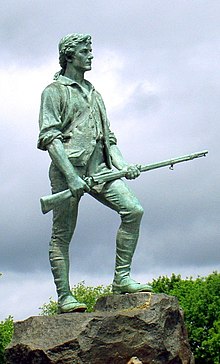Militia Acts (1792)

As Militia Acts two are in 1792 from the Congress of the United States federal laws adopted referred governing the authority of the US President on the residents of the individual states of the United States of America. The laws were superseded by the federal law of 1903 .
They emerged after the defeat in the Battle of the Wabash River in what is now the US state of Ohio . It was then clear that the United States' regular armed forces were not large or strong enough to effectively fight the Indian rebellions in what is now Ohio, Indiana, and Illinois , which in 1792 formed part of the state's Northwest Territory . According to these laws, the president could gain command over all military, male, white residents between the ages of 18 and 45 of individual states, if the need arose due to external or internal threats. In 1862 the law was extended to all male residents between the ages of 18 and 54, regardless of skin color.
The first law was passed on May 2nd, 1792, the second law on May 8th, 1792. The second law regulated the length of an operation that could be ordered by the President, namely 6 months and the equipment that a citizen had to provide : a musket with a bayonet and 24 bullets. The federal government provided a uniform. During the mission, the militiamen should be paid like regular soldiers. Some professional groups have been exempted from compulsory weapons. During the time of their service, the militiamen were subject to United States military law.
According to the law, the states were obliged to set up militias divided into divisions , brigades , regiments , battalions and companies . At least 4 times a year had to be practiced.
The United States had strong political forces during and after its inception that did not want a strong federal military in peacetime. They saw a standing army as a threat to freedom, which is expressed, for example, in the Constitution of the US state of Pennsylvania of September 28, 1776. The municipalities of the states had their own militias, which were democratically administered. Your officers have been elected. Many saw in the armament of the people a guarantor for a functioning, free federal state that could defend itself against a dictatorial federal government in an emergency. The colonies were just breaking away from a British government that was perceived as dictatorial and had a standing army. That is why they did not allow the federal government to have a strong standing army in peacetime. It was not until 1798 that the federal states approved naval and marine infantry units to the federal government, after they were abolished after the Peace of Paris in 1783. The federal Continental Army was also largely disbanded, with only a few federal units remaining to ensure security in federal territories such as the Northwest Territory.
The Insurrection Act of 1807 then exceptionally gave the US President the authority to use the National Guard and Army troops or naval units within the United States to counter insurgency . The Posse Comitatus Act of 1878 restricted this authority again after the end of the Civil War .
See also
Individual evidence
- ↑ An Act to provide for calling forth the Militia to execute the laws of the Union, suppress insurrections and repel invasions.
- ↑ An Act more effectually to provide for the National Defense by establishing an Uniform Militia throughout the United States.
- ^ Yale Law School Constitution of Pennsylvania Constitution of Pennsylvania (Article 13) ... and as standing armies in the time of peace are dangerous to liberty, they ought not to be kept up ...